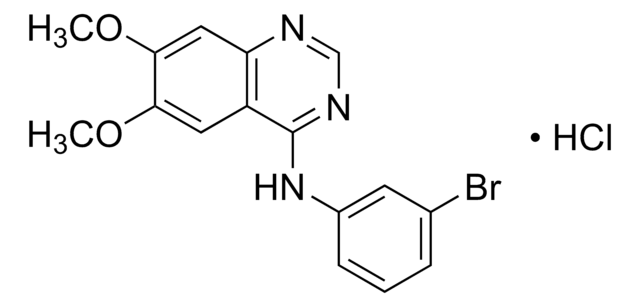234490
PD 153035
An extremely potent, cell-permeamble, reversible, ATP-competitive and specific inhibitor of the tyrosine kinase activity of the epidermal growth factor receptor (EGFR; IC₅₀ = 25 pM; Ki = 6 pM).
Synonym(s):
PD 153035, AG 1517, 4-[(3-Bromophenyl)amino]-6,7-dimethoxyquinazoline, SU 5271, Compound 32
About This Item
Recommended Products
Quality Level
Assay
≥97% (HPLC)
form
solid
potency
25 pM IC50
manufacturer/tradename
Calbiochem®
storage condition
OK to freeze
protect from light
color
white
solubility
DMSO: 5 mg/mL
shipped in
ambient
storage temp.
−20°C
InChI
1S/C16H14BrN3O2/c1-21-14-7-12-13(8-15(14)22-2)18-9-19-16(12)20-11-5-3-4-10(17)6-11/h3-9H,1-2H3,(H,18,19,20)
InChI key
LSPANGZZENHZNJ-UHFFFAOYSA-N
General description
Biochem/physiol Actions
EGFR
Warning
Reconstitution
Other Notes
Fry, D.W., et al. 1994. Science265, 1093.
Legal Information
Storage Class Code
11 - Combustible Solids
WGK
WGK 1
Certificates of Analysis (COA)
Search for Certificates of Analysis (COA) by entering the products Lot/Batch Number. Lot and Batch Numbers can be found on a product’s label following the words ‘Lot’ or ‘Batch’.
Already Own This Product?
Find documentation for the products that you have recently purchased in the Document Library.
Our team of scientists has experience in all areas of research including Life Science, Material Science, Chemical Synthesis, Chromatography, Analytical and many others.
Contact Technical Service








